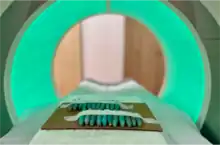Anton Windfelder
Anton George Windfelder is a German zoologist and immunologist whose primary research interests include functional imaging of insects.[1]

Life
Windfelder became known after he established the caterpillars of the tobacco hornworm (Manduca sexta) as an alternative animal model for medical research.[2][3][4][5][6][7][8] His work has received international attention and helps to reduce the number of mammals in medical research according to the 3R principle.[9][10][11][12][13][14][15][16]
Windfelder was born in Berlin, where he also graduated from high school. After this, Windfelder studied biology at the Justus-Liebig University in Giessen, with a major in zoology, and became scientifically active early on during his studies.[17] After graduation, Windfelder became a research associate at the Institute of General Zoology and Developmental Biology in the research group for cellular recognition and defense processes led by Tina Trenczek.[18]
Windfelder received his doctorate in 2021 on the topic "High-throughput screening of insect larvae as a replacement for mammalian models of gut inflammation" from Tina Trenczek and Ulrich Flögel.[19][20] The doctorate was awarded with the highest grade summa cum laude, and Windfelder was awarded the Dr.-Herbert-Stolzenberg-Prize for outstanding achievements in biology in 2023 for his work.[21][22][23] After receiving his doctorate, Windfelder moved to the Fraunhofer Institute for Molecular Biology and Applied Ecology to work with Andreas Vilcinskas. He is also employed at the University Hospital Giessen in Experimental Radiology.[24][25] Windfelder is also involved in university teaching and advocates the use of new didactic methods, such as virtual reality, in medical education.[26][27][5]
During his time in Giessen, Windfelder met his wife. Windfelder is married and has two children.[28]
Scientific work

Windfelder's scientific focus is on the functional imaging of insects.[29][30][3] He exploits medical imaging methods such as computed tomography, magnetic resonance imaging, positron emission tomography, or photoacoustic imaging to study physiological and immunological processes in insects.[3] He was the first scientist to use 18F-fluorodeoxyglucose positron emission tomography (FDG-PET) to show pathological glucose metabolism in tobacco hornworms with gut inflammation[3][31] His work shows that the previously mentioned methods can also be used in insects to detect inflammation in analogy to humans.[3][32][33][34][35]
This allows insects to be better protected from harmful influences such as pesticides, as the adverse effects of these substances can now be detected more easily. On the other hand, insects can be used as alternative animal models in biomedical research.[36][3] Due to the close evolutionary conservation of the innate immune system and the anatomy of the intestinal epithelium between insects and mammals, insects represent excellent models for studying gut inflammation.[37][35][38] For this purpose, Windfelder and his team established the larvae of the tobacco hornworm (Manduca sexta) using the above methods as an alternative animal model for chronic inflammatory bowel diseases such as Crohn's disease and ulcerative colitis.[3][39][40][35] In addition, new promising contrast agents for radiology or tracers for nuclear medicine can first be tested on insects instead of mice or rats, as was previously the case.[30][35][41] Since Windfelder's research helps reduce the number of experiments involving small mammals, his research also significantly contributes to animal welfare (3Rs principle).[3][42]
Literature (selection)
- Windfelder, Anton G., et al. "High-throughput screening of caterpillars as a platform to study host–microbe interactions and enteric immunity." Nature communications 13.1 (2022): 7216.
- Windfelder, Anton G., et al. "A quantitative micro-tomographic gut atlas of the lepidopteran model insect Manduca sexta." iScience 26.6 (2023).
- Koshkina, Olga, et al. "Biodegradable polyphosphoester micelles act as both background-free 31P magnetic resonance imaging agents and drug nanocarriers." Nature Communications 14.1 (2023): 4351.
- Laussmann, Tim, et al. "Dynamic monitoring of vital functions and tissue re-organization in Saturnia pavonia (Lepidoptera, Saturniidae) during final metamorphosis by non-invasive MRI." Scientific Reports 12.1 (2022): 1105
- Müller, F. H. H., et al. "Positron emission mammography in the diagnosis of breast cancer." Nuklearmedizin-NuclearMedicine 55.01 (2016): 15–20.
References
- "Development of alternatives to mammalian models in medicine – Fraunhofer IME". Fraunhofer Institute for Molecular Biology and Applied Ecology IME. Retrieved 3 September 2023.
- hessenschau de, Frankfurt Germany (6 January 2023). "Tabakschwärmer-Larve gegen Darmerkrankungen" (in German). Retrieved 2 September 2023.
- Windfelder, Anton G.; Müller, Frank H. H.; Mc Larney, Benedict; Hentschel, Michael; Böhringer, Anna Christina; von Bredow, Christoph-Rüdiger; Leinberger, Florian H.; Kampschulte, Marian; Maier, Lorenz; von Bredow, Yvette M.; Flocke, Vera; Merzendorfer, Hans; Krombach, Gabriele A.; Vilcinskas, Andreas; Grimm, Jan (24 November 2022). "High-throughput screening of caterpillars as a platform to study host–microbe interactions and enteric immunity". Nature Communications. 13 (1). doi:10.1038/s41467-022-34865-7. ISSN 2041-1723. PMC 9700799. PMID 36433960.
- "Statt Tierversuchen an Mäusen: Kleine Kriecher revolutionieren die Medikamentenforschung". rtl.de (in German). 9 February 2023. Retrieved 2 September 2023.
- Martin Vieweg (16 June 2023). "Virtuelle Reise durch die „Raupe der Forschung"" (in German). Retrieved 2 September 2023.
- "Grundlagenforschung: Raupen statt Mäuse" (in German). Retrieved 2 September 2023.
- "Move Over, Mice: Caterpillars Could Replace Some Mammals in the Study of Human Disease | Memorial Sloan Kettering Cancer Center". www.mskcc.org. 12 January 2023. Retrieved 3 September 2023.
- "Audio – Fraunhofer IME". Fraunhofer-Institut für Molekularbiologie und Angewandte Oekologie IME (in German). Retrieved 3 September 2023.
- "Caterpillars as a replacement for mammalian models in preclinical research – Research team developed an innovative and unique imaging platform". www.bionity.com. Retrieved 3 September 2023.
- "Introducing... The Caterpillar Model of Human Disease | Health And Medicine". Labroots. Retrieved 3 September 2023.
- "Virtual journey through the "caterpillar of research"". Techzle. 16 June 2023. Retrieved 3 September 2023.
- "Caterpillars could be used as an alternative to mammalian models to study gut inflammation". 12 January 2023. Retrieved 2 September 2023.
- "Fim dos ratos em experimentos? Lagartas podem substituir os roedores" (in Portuguese). 12 January 2023. Retrieved 2 September 2023.
- "COVID-19 antibodies in breast milk, Martian meteorite & more". 16 January 2023. Retrieved 2 September 2023.
- Liana Ganea. "Omizile ar putea înlocui șoarecii în studiul bolilor umane" (in Romanian). Retrieved 2 September 2023.
- "Understanding gut inflammation using caterpillars | Immunopaedia". Immunopaedia | Advancing global immunology education. 19 January 2023. Retrieved 3 September 2023.
- Müller, F. H. H.; Farahati, J.; Müller, A. G.; Gillman, E.; Hentschel, M. (2016). "Positron emission mammography in the diagnosis of breast cancer: Is maximum PEM uptake value a valuable threshold for malignant breast cancer detection?". Nuklearmedizin (in German). 55 (01): 15–20. doi:10.3413/Nukmed-0753-15-07. ISSN 0029-5566.
- "Prof. Dr. Tina E. Trenczek". Justus-Liebig-Universität Gießen (in German). Retrieved 2 September 2023.
- Windfelder, Anton George (2021). High-throughput screening of insect larvae as a replacement for mammalian models of gut inflammation. Justus-Liebig-Universität Gießen. Giessen.
{{cite book}}: CS1 maint: location missing publisher (link) - "Suchportal UB Gießen: Titel: High-throughput screening..." Retrieved 2 September 2023.
- "Förderung der Jungwissenschaftler" (in German). 4 July 2023. Retrieved 2 September 2023.
- "Stolzenberg-Preis für Windfelder" (in German). 11 July 2023. Retrieved 2 September 2023.
- "Herausragende Leistung am Fraunhofer IME in Gießen" (in German). 13 July 2023. Retrieved 2 September 2023.
- "Entwicklung von Alternativen zu Säugetiermodellen in der Medizin – Fraunhofer IME" (in German). Retrieved 2 September 2023.
- "Universitätsklinikum Giessen und Marburg – Team" (in German). Retrieved 2 September 2023.
- "„Gamechanger": Gießener Team forscht mit VR-Technik an Darmerkrankungen" (in German). 3 July 2023. Retrieved 2 September 2023.
- "Virtual journey through the "caterpillar of research"". Techzle. 16 June 2023. Retrieved 3 September 2023.
- "Short CV | Anton Windfelder | Alternative Animal Models". Meinewebsite. Retrieved 15 September 2023.
- Windfelder, Anton G.; Steinbart, Jessica; Flögel, Ulrich; Scherberich, Jan; Kampschulte, Marian; Krombach, Gabriele A.; Vilcinskas, Andreas (June 2023). "A quantitative micro-tomographic gut atlas of the lepidopteran model insect Manduca sexta". iScience. 26 (6): 106801. doi:10.1016/j.isci.2023.106801. ISSN 2589-0042. PMC 10291339. PMID 37378344.
- Koshkina, Olga; Rheinberger, Timo; Flocke, Vera; Windfelder, Anton; Bouvain, Pascal; Hamelmann, Naomi M.; Paulusse, Jos M. J.; Gojzewski, Hubert; Flögel, Ulrich; Wurm, Frederik R. (19 July 2023). "Biodegradable polyphosphoester micelles act as both background-free 31P magnetic resonance imaging agents and drug nanocarriers". Nature Communications. 14 (1): 4351. doi:10.1038/s41467-023-40089-0. ISSN 2041-1723. PMC 10356825. PMID 37468502.
- "BPoD | PET Caterpillars". bpod.org.uk. Retrieved 3 September 2023.
- "Ein neues Labortier für die Darmforschung". AerzteZeitung.de (in German). 8 December 2022. Retrieved 3 September 2023.
- "Tabakschwärmer helfen beim Verständnis entzündlicher Prozesse". www.diepta.de (in German). 6 December 2022. Retrieved 3 September 2023.
- Ärzteblatt, Deutscher Ärzteverlag GmbH, Redaktion Deutsches (13 December 2022). "Tabakschwärmer-Raupen als neuer Modellorganismus für präklinische Studien". Deutsches Ärzteblatt (in German). Retrieved 3 September 2023.
{{cite web}}: CS1 maint: multiple names: authors list (link) - Journalist, Volker Budinger, Diplom-Biologe, freier (22 December 2022). "Schmetterlingsraupen für die Erforschung von Darmerkrankungen". DAZ.online. Retrieved 3 September 2023.
{{cite web}}: CS1 maint: multiple names: authors list (link) - KG, Georg Thieme Verlag (6 January 2023). "Vet-News: Schädlingsraupen als Ersatz für Versuchstiere?!". vet.thieme.de (in German). Retrieved 3 September 2023.
- Anthony Galenza, Edan Foley (1 May 2019), "Immunometabolism: Insights from the Drosophila model", Developmental & Comparative Immunology, vol. 94, pp. 22–34, doi:10.1016/j.dci.2019.01.011, ISSN 0145-305X, retrieved 2 September 2023doi:10.1016/j.dci.2019.01.01
- "Schädlingsraupen können traditionelle Versuchstiere ersetzen- Technologieland Hessen". www.technologieland-hessen.de (in German). Retrieved 3 September 2023.
- Ärzteblatt, Deutscher Ärzteverlag GmbH, Redaktion Deutsches (13 December 2022). "Tabakschwärmer-Raupen als neuer Modellorganismus für präklinische Studien". Deutsches Ärzteblatt (in German). Retrieved 3 September 2023.
{{cite web}}: CS1 maint: multiple names: authors list (link) - Journalist, Volker Budinger, Diplom-Biologe, freier (22 December 2022). "Schmetterlingsraupen für die Erforschung von Darmerkrankungen". DAZ.online. Retrieved 3 September 2023.
{{cite web}}: CS1 maint: multiple names: authors list (link) - "Biodegradable phosphoester polymers for greener MRI color". cen.acs.org. Retrieved 4 September 2023.
- "Das 3R-Prinzip". Tierversuche verstehen (in German). Retrieved 2 September 2023.
External links
- Official website
- Anton Windfelder publications indexed by Google Scholar
- The development of alternatives to mammalian models in medicine at the Fraunhofer Institute for Molecular Biology and Applied Ecology
- University Hospital Giessen Project page (German)
- Tobacco hawk moth larva against intestinal diseases TV contribution (German)
- Instead of animal experiments on mice: Are these little creepers revolutionizing drug research? TV contribution (German)
- Virtual journey through the caterpillar of research at Bild der Wissenschaft (German)
- Caterpillars instead of mice at Spektrum der Wissenschaft (German)